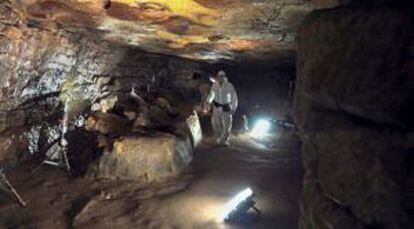Altamira must be closed to visitors, Spanish scientists tell Unesco
Scholars accuse government of endangering Paleolithic cave art for political reasons


The future of the Altamira caves, home to one of the most spectacular examples of Paleolithic art on the planet, is to be decided over the next few weeks.
A year after the Unesco World Heritage Site in Cantabria, northern Spain, was opened to weekly visits by small groups, a decision is due on whether to continue allowing public access to the caves.
The Prehistory Department at Madrid’s Complutense University has sent a letter to Unesco criticizing the Spanish Culture Ministry’s desire to reopen the cave, noting that “allowing visitors to the cave raises important questions about its conservation and endangers a fragile legacy of great importance for our understanding of Paleolithic society.”
The open letter, signed by 17 academics, is also supported by around 70 researchers from the History Institute of the Spanish National Research Council, known as the CSIC.
A long story
The Altamira caves were closed to the public in 1977 after several decades’ worth of visits had caused them to deteriorate. They were reopened to small groups in 1982, and then closed again in 2002.
In 2014, based on a survey that said that opening the caves would not damage the paintings, the Spanish culture ministry decided to admit small groups of visitors. Over the last year, around 250 people have been allowed in. The Spanish National Research Council’s own report said visits could damage the cave.
A replica of the cave was created at the Altamira museum and opened to the public in 2001.
The Altamira authorities have to decide over the next few weeks whether to continue allowing small groups into the cave.
“Spain has the obligation to study the cave scientifically and to share any information, as well as to preserve this heritage for future generations,” the letter continues. “The action taken by the Spanish Culture Ministry is a clear threat to its conservation. We believe that Unesco and other international organizations dedicated to preserving cultural heritage should take note of the dangers that political decisions pose for the conservation of Altamira.”
The scholars say that despite the potential dangers of allowing visitors into the caves, the Culture Ministry has done everything possible to reopen Altamira. This approach differs markedly from that of French authorities, who have closed the Lascaux and Chauvet caves, which also contain Paleolithic art. The museum at Lascaux houses a replica of the cave, complete with its paintings, while another faithful copy is planned at Chauvet. The Altamira caves have also been faithfully recreated in a replica located inside the site’s museum.
Altamira was closed to the public in 2002 after years of tourist visits. Several CSIC teams, led by Sergio Sánchez-Moral and Cesáreo Saiz-Jiménez, two of the world’s leading experts in cave art, carried out a survey of the cave between 1996 and 2012, in some cases involving experimental visits. Their preliminary results were published in the journal Science in 2011 and formed the basis of a subsequent report for the Culture Ministry that left no doubt about the dangers posed by visitors: “Any existing threshold of risk has already been crossed,” warned the study.
In response, the ministry commissioned French archeologist Gaël de Guichen to prepare a second report to establish a comprehensive cave preservation plan. The ministry’s idea was for a weekly raffle that would allow 250 people to visit the caves each year in groups of five plus a guide, spending 37 minutes underground. The raffle scheme ended in February of this year.
Now, the board of trustees of Altamira must decide whether to keep up these visits indefinitely or not. No specific date has been set for a meeting of the board, which was originally planned for March or April.
The majority of experts believe that limited numbers of people will be allowed to keep visiting the cave, since the second report claims that any deterioration of the paintings is natural and not made worse by human contact. José Antonio Lasheras, the director of Altamira since 1991, has declined to comment on the issue.

Speaking to EL PAÍS in October 2014, he said: “Management’s mission is to regulate proper conservation and use of the caves, and it could be that what was once considered appropriate is no longer so, and vice-versa. I proposed closing the cave in 2002 and take responsibility for the current public visit regime. Since the Altamira Museum was created, closures have been temporary and public access conditional on the requirements of conservation.”
Lasheras has made it clear on several occasions that he is in favor of reopening the cave to the public.
Teresa Chapa, a professor of Prehistory at Complutense University who signed the open letter to Unesco, explains: ‟These days, the trend is toward closing decorated caves and investing in copies, yet in Altamira we are seeing a move in the opposite direction.”
Any existing threshold of risk has already been crossed”
Chapa says most international experts believe public access to such caves should be restricted, particularly after the damage caused by earlier unfettered access to Lascaux and Altamira.
Jesús Álvarez Sanchís has accused the Spanish culture ministry of seeking to exploit the tourist and marketing value of the caves.
“Attempting to reopen them represents a complete lack of sensitivity for a place that belongs to all of humanity – not to Cantabria and not to Spain. The underlying reasons have nothing to do with science or heritage, but with politics,” he says.
The Culture Ministry has declined to comment on the academics’ letter, but denies that the bid to reopen the caves permanently is due to political pressure.










































